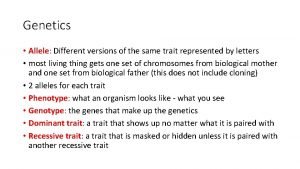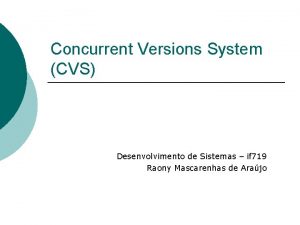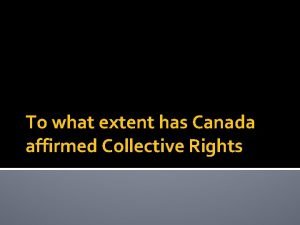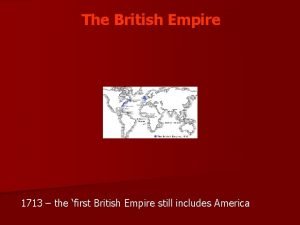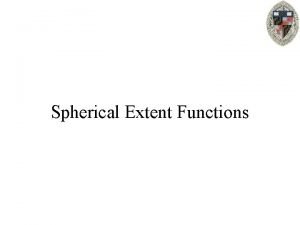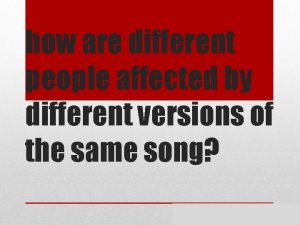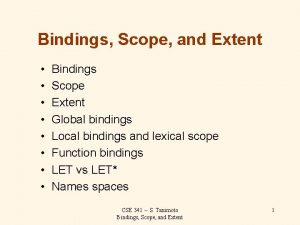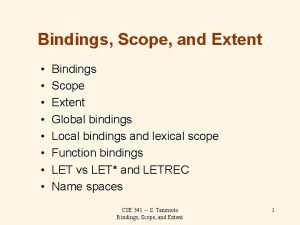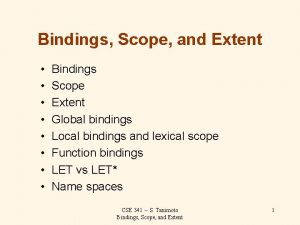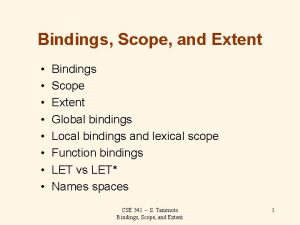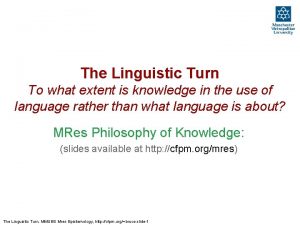To what extent can the different linguistic versions










- Slides: 10

To what extent can the different linguistic versions of the same text be mutually enriching? The example of the Cape Town Convention Pr. Jean-François RIFFARD Clermont Auvergne University School of Law

THE PROBLEM : the interaction between the different language versions of the Convention A « NON PROBLEM » ? 2 Arguments : VIENNA CONVENTION ON THE LAW OF TREATIES (1969) Article 33 : Interpretation of treaties authenticated in twoor more languages 1. When a treaty has been authenticated in two or more languages, the text is equally authoritative in each language, unless the treaty provides or the parties agree that, in case of divergence, a particular text shall prevail. (…) 3. The terms of a treaty are presumed to have the same meaning in each authentic text. CTC Final Dispositions DONE at Cape Town, this sixteenth day of November, two thousand one, in a single original in the English, Arabic, Chinese, French, Russian and Spanish languages, all texts being equally authentic, such authenticity to take effect upon verification by the Joint Secretariat of the Conference under the authority of the President of the Conference within ninety days hereof as to the conformity of the texts with one another.

A « NON PROBLEM » which is…. . A PURE FICTION ! It is certain, from a comparative point of view, that the perfect identity between different. It language versions of the same text does not exist. Cannot exist. WHY ? Reason 1 TERMINOLOGY : Any legal rule is expressed in a specific language that therefore becomes an essential element of it. Any legal terms is dependent on the entire domestic legal system that created it. legal language is the reflection and vehicle of a certain conception of the law. Reaon 2 : STYLE : Each language has its own style rules. For example, while in English we have no problem using the same word in the same sentence, the aversion of the French to repetition will push them to use either synonyms or different sentence turns. Does a drafter have to favour elegance of style or legal certainty ?

So there are necessarily differences between the different versions QUESTION : Can these differences become a source of enrichment ? May the reference to another language version help to clarify the interpretation of the convention ? EXAMPLE 1 : Can the English version enlight the French one ? Article 13 — Mesures provisoires 1. Sous réserve de toute déclaration qui pourrait être faite en vertu de l’article 55, tout État contractant veille à ce qu’un créancier qui apporte la preuve de l’inexécution des obligations par le débiteur puisse, avant le règlement au fond du litige et pour autant qu’il y ait consenti, ledit consentement pouvant être donné à tout moment, obtenir dans un bref délai du tribunal une ou plusieurs des mesures suivantes demandées par le créancier (…) : Who is IL (he) ? The French version is unclear : - obviously : the debtor - But grammatically speaking : the creditor !

NO QUESTION IN ENGLISH : Article 13 — Relief pending final determination 1. Subject to any declaration that it may make under Article 55, a Contracting State shall ensure that a creditor who adduces evidence of default by the debtor may, pending final determination of its claim and to the extent that the debtor has at any time so agreed, obtain from a court speedy relief in the form of such one or more of the following orders as the creditor requests (…) : The repetition of “the debtor” makes the text very clear… but inelegant in French !

EXAMPLE 2 : CAN THE FRENCH VERSION ENLIGHT THE ENGLISH ONE ? ART. XXV RAIL PROTOCOL A CONTRACTING STATE MAY, AT ANY TIME, DECLARE THAT IT WILL CONTINUE TO APPLY, TO THE EXTENT SPECIFIED IN ITS DECLARATION, RULES OF ITS LAW IN FORCE AT THAT TIME WHICH PRECLUDE, SUSPEND OR GOVERN THE EXERCISE WITHIN ITS TERRITORY OF ANY OF THE REMEDIES SPECIFIED IN CHAPTER III OF THE CONVENTION AND ARTICLES VII TO IX OF THIS PROTOCOL IN RELATION TO RAILWAY ROLLING STOCK HABITUALLY USED FOR THE PURPOSE OF PROVIDING A SERVICE OF PUBLIC IMPORTANCE (“PUBLIC SERVICE RAILWAY ROLLING STOCK”) AS SPECIFIED IN THAT DECLARATION NOTIFIED TO THE DEPOSITARY. “AS SPECIFIED” REFERS TO WHAT ? - THE RULES OF ITS LAW ? - RAILWAY ROLLING STOCK ?

NO QUESTION IN FRENCH : ART. XXV RAIL PROTOCOL UN ÉTAT CONTRACTANT PEUT DÉCLARER À TOUT MOMENT QU’IL CONTINUERA D’APPLIQUER, DANS LA MESURE PRÉCISÉE DANS SA DÉCLARATION, SES RÈGLES DE DROIT EN VIGUEUR À CE MOMENT QUI INTERDISENT, SUSPENDENT OU RÉGLEMENTENT L’EXERCICE SUR SON TERRITOIRE DES MESURES VISÉES AU CHAPITRE III DE LA CONVENTION ET AUX ARTICLES VII À IX DU PRÉSENT PROTOCOLE, CONCERNANT LE MATÉRIEL ROULANT FERROVIAIRE HABITUELLEMENT UTILISÉ POUR FOURNIR UN SERVICE D’IMPORTANCE PUBLIQUE (“MATÉRIEL ROULANT FERROVIAIRE AFFECTÉ AU SERVICE PUBLIC”), TEL QUE PRÉCISÉ DANS SA DÉCLARATION NOTIFIÉE AU DÉPOSITAIRE. TEL QUE : MASCULINE ET SINGULAR REFERS NECESSARILY TO RAILWAY ROLLING STOCK !

NEW : CAN WE RELY ON THE FRENCH VERSIONS TO INTERPRET THE ENGLISH ONE ? THE ANSWER TO THIS QUESTION DEPENDS ON THE ANSWER TO ANOTHER, MORE FUNDAMENTAL QUESTION: HOW WERE THESE DIFFERENT VERSIONS WRITTEN ? TWO ANSWERS : OPTION 1 : HAVE THEY BEEN DRAFTED IN PARALLEL, IN A BILINGUAL DRAFTING COMMITTEE, IN WHICH THE ENGLISH AND FRENCH DRAFTERS (WORKING LANGUAGES) AGREED ON THE MEANING AND SCOPE OF THE RULE BEFORE WRITING THEIR RESPECTIVE VERSIONS IN THEIR OWN LANGUAGES ? OPTION 2 : IS THE FRENCH VERSION ONLY THE TRANSLATION OF THE ENGLISH VERSION, THE LANGUAGE IN WHICH THE TEXT WAS NEGOTIATED, DISCUSSED AND DRAFTED BEFORE BEING TRANSLATED NOT ONLY INTO THE OTHER WORKING LANGUAGE, BUT ALSO INTO THE OTHER OFFICIAL LANGUAGES. ?

IF OPTION 1 : THE FRENCH VERSION HAS THE SAME VALUE ANF CAN BE USED AS AN INTERPRETATION BUT : This situation is very rare ! It assumes that the drafting committee will be composed of members who are all bilingual. IF OPTION 2 : TRADUTTORE, TRADITORE ! Then a new question arises : WHO translated the text ? - A lawyer with linguistic skills ? - A Linguist with some legal knowledge ? - An Algorithm ?

CONCLUSION : BECAUSE OF THE TRANSLATION, IT IS MOST OFTEN LIKELY THAT THE DIFFERENCE WILL NOT BE CONSCIOUS BUT WILL RESULT FROM A STYLISTIC REQUIREMENT. IF THE PERSON IN CHARGE IS NOT A LAWYER, OR IF HE OR SHE DID NOT PARTICIPATE IN THE DRAFTING COMITEE IT IS DIFFICULT TO DEDUCE FROM THIS THAT THE DIFFERENCE IN FRENCH BETTER REFLECTS THE SPIRIT AND DEEP MEANING OF THE TEXT. SOLUTION ? IT IS IMPERATIVE THAT UNIDROIT BE TRANSPARENT ABOUT THE PROCESS OF PREPARING THE DIFFERENT VERSIONS AND ABOUT THE TRANSLATION WORK IN ORDER TO ASSURE PRACTITIONERS (JUDGES, LAWYERS) OF THE VALUE OF EACH VERSION IN RELATION TO THE ENGLISH INITIAL VERSION.
 Gender roles in snow white
Gender roles in snow white Different versions of the same trait
Different versions of the same trait Which bird can rotate its neck backwards to a large extent
Which bird can rotate its neck backwards to a large extent How do neurotransmitters influence behavior
How do neurotransmitters influence behavior Concurrent versions system
Concurrent versions system Ranura agp
Ranura agp What is maltego
What is maltego What is spm
What is spm Sic addressing modes
Sic addressing modes To what extent has canada affirmed collective rights
To what extent has canada affirmed collective rights Uk at its greatest extent
Uk at its greatest extent

